After the insurrection: How domestic extremists adapted and evolved after the January 6 US Capitol attack
This report by the Digital Forensic Research Lab (DFRLab) provides an overview and analysis of the shifts observed in domestic extremist movements since the 2021 Capitol attack.
After the insurrection: How domestic extremists adapted and evolved after the January 6 US Capitol attack

Table of contents
Photo: MICHAEL BROCHSTEIN/ZUMA PRESS
Executive summary
Domestic extremist movements have evolved and adapted their strategies, infrastructure, and messaging in the year since the insurrection at the US Capitol Building on January 6, 2021. Such movements were initially jubilant at the sight of extremist groups and former President Donald Trump’s most ardent supporters crashing through windows and brawling with police, temporarily halting the US Congress as it certified the 2020 election results. But, resulting arrests and scrutiny soured that cheer into a wicked brew of paranoia and fear that played out among these movements, both online and offline.
After a short period of relative inactivity, some radical movements began to resurface publicly. By the summer of 2021, other movements reorganized, making strategic adjustments along the way.
This report by the Digital Forensic Research Lab (DFRLab) provides an overview and analysis of the shifts observed in domestic extremist movements since the 2021 Capitol attack. As noted in the National Strategy for Countering Domestic Terrorism, domestic extremist threats include groups and individuals “whose racial, ethnic, or religious hatred leads them toward violence” and those who incite “imminent violence in opposition to legislative, regulatory, or other actions taken by the government,” including self-proclaimed militias, “sovereign citizen” movements, and others promoting fringe ideological grievances. This research is informed by continued online monitoring and analysis of extremist individuals, groups, and movements, and how their online behavior influences offline activities. Daily monitoring efforts, primarily comprising open-source and investigative reporting, began in the latter half of 2020 and continued through the entirety of 2021, producing a comprehensive record of extremist movements online that informed this report, as well as other efforts to combat the threats that domestic extremist movements pose to democracy and public safety.
Summary of findings
Aftermath of the riot:
- Various domestic extremist movements and their supporters cheered the January 6 US Capitol attack but became paralyzed by paranoia. Perceived momentum gained throughout 2020 saw a brief freeze, as initial waves of arrests and public scrutiny disrupted organizing and activities.
- Various movements or loosely organized groups planned and encouraged follow-up events, but most were eventually canceled. Widespread suspicion, of both each other and federal authorities, led many movements to discourage attendance at public political events and accuse one another of cooperating with investigators.
- Social media companies and online platforms took further actions against extremist content and activities, leading to a “great scattering” of extremists and extremist groups across alternative platforms. Movements, groups, and individuals present during the attack were subjected to additional scrutiny by tech companies. Many central figures lost access to mainstream digital services, forcing them to disperse across alternative online spaces.
- Many extremist groups and far-right platforms were targets of data scrapes, breaches, and hacks. Researchers and digital sleuths monitored extremist groups and alternative social media platforms to gather open-source data, while hackers actively infiltrated them. Many of these efforts were made available to researchers and journalists, who, in turn, revealed previously unknown details about them, including personal information.
Adoption of new offline methods:
- Some extremist movements have attempted to push into mainstream conservative politics. By forming nonprofits and conducting traditional political activities like phone banking and hosting conferences, extremist movements have sought to establish political legitimacy within mainstream conservative circles to attract support.
- Others have looked to decentralize their organizations. Some groups have sought to evade scrutiny by operating autonomously from central national groups and encouraging individuals or small groups to work independently toward broader goals.
- Movement leaders are overwhelmingly encouraging local over national actions. This has led many to adopt causes embraced by mainstream conservatives, from fighting COVID-19 restrictions to challenging school curricula, directing their ire at local officials.
Adoption of new online methods:
- Banned movements and disaffected supporters have utilized a number of alternative platforms, eventually settling on a handful of them. After migrating from platform to platform, many extremist movements have settled on primary alternative platforms, which vary from community to community.
- Far-right entrepreneurs dissatisfied with current digital platforms have built alternative ones. Some extremists and far-right sympathizers have created platforms to maintain control and independence, ensuring content is not removed without their explicit approval. Among these are Gab Chief Executive Officer Andrew Torba, who has stated he is attempting to build a “parallel Christian economy,” as well as video platforms launched by white nationalist Nicholas Fuentes and conspiracist pillow maven Mike Lindell.
- Movements have resumed efforts to inject their propaganda more broadly into online “culture war” debates. As a fruitful opportunity for generating outrage and hate, extremists have embraced emotionally charged social issues as an entry vehicle into mainstream online discourse.
Historical revisionism:
- Right-wing influencers and politicians have worked to obfuscate and distort the events of January 6, engaging in historical revisionism. Fringe outlets including Gateway Pundit and Revolver alongside politicians such as Reps. Paul Gosar (R-AZ) and Marjorie Taylor Greene (R-GA) have used their platforms to engage in historical revisionism regarding the Capitol riot, disputing the behavior of participants despite documentary evidence to the contrary, and accusing the government of conducting a conspiracy against Trump supporters.
These findings portray a domestic extremist landscape that was battered by the blowback it faced after the Capitol riot, but not broken by it. In fact, the sentiments espoused by domestic extremist causes are as public and insidious as ever, making their way into mainstream conservative discourse. This underscores the importance of periodic accounting and strategizing of methods to confront threats. Just as extremist movements adapt and evolve, so should approaches to preventing the harms they produce.
Introduction
This report offers analysis of the ways that domestic extremist movements evolved and adapted during the year following the now-infamous insurrection at the US Capitol Building on January 6, 2021. On that day, supporters of then-President Donald Trump and likeminded members of extremist movements participated in an assault on democracy itself, violently breaking into the US Capitol as Congress attempted to certify President-elect Joe Biden’s electoral victory. Though none of the last-minute plot twists that drew expectant crowds to Washington came to bear, the attack resulted in several deaths, hundreds of arrests, and a nation shaken by what transpired that afternoon.
Since the attack, US public officials and federal law enforcement have repeatedly identified the need for renewed vigilance in confronting domestic extremism as a leading threat to national security. The Office of the Director of National Intelligence stated in March 2021 that domestic extremist threats posed increased risks, citing the Capitol attack and conspiracy theories as potential motivations for violence. The Biden administration spent its first year in office crafting a policy plan for addressing such threats, including the establishment of the country’s first National Strategy for Countering Domestic Terrorism. Meanwhile in Congress, the House established the Select Committee to Investigate the January 6th Attack on the United States Capitol.
This report focuses on right-wing extremist movements and groups due to their central role in the January 6 attack and their ongoing affront to democratic values, and because public safety, security, and law-enforcement officials agree that they present the most immediate, violent threat to public safety in the United States. Groups identified as far-right and extremist in this report are those that seek to advance agenda items that are based in hate and conspiracy theories, seek to undermine democratic norms and equality, and have records of supporters engaging in violence in pursuit of those ends.
Since the attack, domestic extremist movements have modified their strategies, structures, and ideologies to survive the post-January 6 backlash. This backlash includes public condemnation from elected officials and public figures, increased scrutiny by federal law enforcement and the media, and intensified restrictions by social media platforms and online service providers, among others. Many extremists have turned to alternative online venues to reestablish their digital presence after being de-platformed by mainstream social media companies, as leaders of extremist movements are increasingly encouraging their members to engage at a more grassroots level to spread their beliefs locally while evading the national spotlight. While these efforts have yet to restore many movements to their previous levels of organization and influence, many have plotted new courses, actively attempting to rebuild and rebrand themselves in a post-January 6 world.
The DFRLab is publishing this report with the goal of providing a more granular understanding of the broad spectrum of radicalization that led to the events of January 6, 2021, the state of play among far-right domestic extremist movements, and the ongoing threat of political violence in the United States.
Before the attack: From Stop the Steal to the Capitol steps
In the year leading up to the Capitol insurrection, extremist groups and likeminded, but otherwise unaffiliated, Trump supporters worked in sync to pursue overlapping ideological goals. This synergy peaked following the November 2020 US presidential election with the rise of the “Stop the Steal” movement to prevent President-Elect Joe Biden from taking office, which frequently featured far-right speakers and extremist groups at pro-Trump rallies.
As the DFRLab previously reported in its timeline of the Stop the Steal movement:
The Stop the Steal movement was far from monolithic, though, and included groups across a spectrum of radicalization: hyperpartisan pro-Trump activists and media outlets; the neo-fascist Proud Boys, a group with chapters committed to racism and the promotion of street violence; unlawful militias from around the country with a high degree of command and control, including the so-called Three Percenters movement; adherents to the collective delusion of QAnon; individuals identifying with the Boogaloo Bois, a loosely organized antigovernment group that has called for a second civil war; and ideological fellow travelers of the far-right, who wanted to witness something they believed would be spectacular.
When the Capitol was attacked, both supporters of extremist movements and individuals who shared their conspiratorial views about the election participated in the event. Members of unlawful paramilitary groups like the Oath Keepers and Three Percenters, white-nationalist movements following groups like Nationalist Socialist Club and figureheads like Nicholas Fuentes, conspiracy-theory extremist movements like QAnon, and far-right violent groups like the Proud Boys joined sympathetic Trump supporters in forcing entry into the Capitol. Outside the halls of Congress, a broader network of far-right and pro-Trump influencers watched as months of extreme rhetoric and calls to action bore violent and deadly fruit.
Before and during the Capitol attack, participants and their online supporters communicated using mainstream social media platforms and a host of alternatives where they had carved out niche communities. Some of these so-called “alt” platforms—like Parler, Gab, and The Donald—were built to enable them, while others like MeWe were seemingly chosen for convenience.
For months preceding January 6, these movements engaged each other in hope of undermining the election of Joe Biden. As they plotted events and incited each other online, many tech companies and online platforms struggled to adopt policies to address the growing problem. President Trump paid brief visits to several of the Stop the Steal rallies in Washington via presidential motorcade and Marine One flyovers. Many Republican officials, following Trump’s lead, offered legitimacy to this brewing movement; despite the Capitol attack, one hundred and forty-seven Republican members of Congress voted against certifying Biden’s win. Presented with little resistance, this collage of Trump supporters and like-minded extremist groups carried out a direct assault against a fundamental pillar of US democracy: the peaceful transition of power from one administration to the next.
“They are watching”: Bombast, then blowback
The attack on the US Capitol was initially successful in its brief disruption of the formal certification of the 2020 election, but ultimately failed in its aim of subverting the entire process. In the immediate aftermath, online sympathizers and members of extremist movements cheered the violent scene that had played out before the nation. One user in a militia-movement group on the social media platform MeWe asked hundreds of others in the group’s chatroom, “Where do we go from here? Obviously we need to organize and OVERWHELMING FORCE, and KILL THEM ALL!” In response, another user shared a screenshot of a message posted by Trump attorney and conspiracy theorist Lin Wood calling to “get the firing squads ready,” and adding that then-Vice President Mike Pence “goes FIRST.”“Rogue Nation Eternal Militia,” MeWe, January 6, 2020.
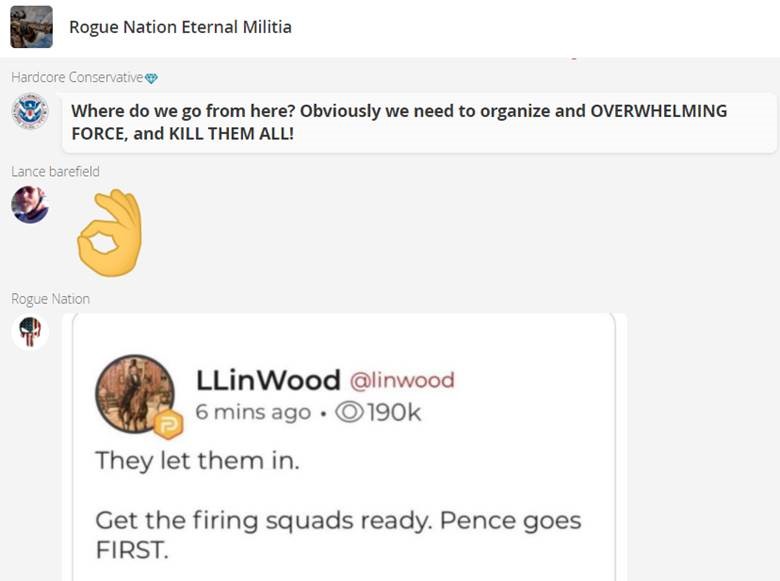
Messages containing identical sentiments were commonplace among far-right audiences in the aftermath of the attack. In several online spaces popular with extremists, January 6 was proclaimed as the first shot fired in a new revolution against the US government. These communities believed that government agencies and officials should be punished for not keeping Trump in office, based on a false belief that they had contributed to a vast conspiracy to expel him from a divinely righteous reign over the executive branch. Several white-supremacist movements invoked imagery of the Capitol attack to celebrate the start of a “white revolution” against the government. Extremist communities mourned and vowed revenge for Ashli Babbitt, who was shot and killed by a police officer while attempting to forcibly enter the US House of Representatives through a window broken by the violent mob.
“We need to find out who the LEO Red Coat was today who murdered Ashli Babbit [sic] and arrest that bum and execute him,” one user wrote to fellow members of the antigovernment Oath Keepers late on the night of January 6, in a private chat room on the platform rocket.chat. “No more games, no more talk. There is not [a] political solution or legal solution to a communist coup.” Another user replied, “I think that was the shot that killed any possibility of peace.”
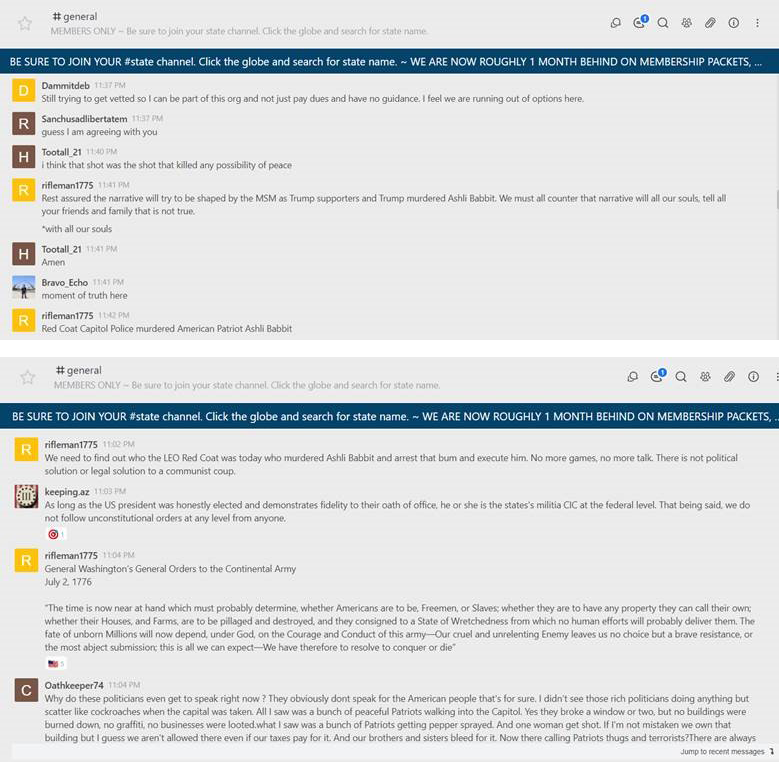
Narrative: Ashli Babbitt is a martyr who died under unclear circumstances
January – early April
Far-right communities online fume over Babbitt’s death and attempt to identify and harass the office they believe shot her.
May 12
Rep. Paul Gosar questions former Attorney General Jeffrey Rosen about the death of Babbitt, claiming she was “executed.”
June 14
Babbitt’s husband appears on Tucker Carlson Tonight and asks for the officer who killed Babbitt to be identified.
June 16
Rep. Gosar demands the name of Babbitt’s killer from FBI director Christopher Wray.
July 1
Donald Trump issues a statement asking, “Who shot Ashli Babbitt?”
July 6
Rep. Gosar releases a statement asking who killed Babbitt and furthers his previous conspiratorial comments.
July 7
Rep. Marjorie Taylor Greene says she would have been friends with Babbitt, compares her killing to that of George Floyd.
July 11
Trump furthers Babbitt conspiracies on Fox News and describes her as “innocent, wonderful, incredible.”
October 11
In a video marking Babbitt’s birthday, Trump describes her as a “truly incredible person” whose memory will live on “for all time.”

The last proposal suggested that armed individuals would appear at a variety of locations, including the headquarters of broadcast news outlets like CNN and social media companies like Facebook. One chatroom member rhetorically invoked the name of Timothy McVeigh, the far-right, antigovernment terrorist responsible for the 1995 Oklahoma City Bombing that killed one hundred sixty-eight people and injured hundreds of others. “Can we bond Timothy McVeigh out of prison and give him [Facebook’s] address?” they asked. (McVeigh was executed in 2001.) Ultimately, the most violent fantasies failed to materialize, and the movement’s initial glorification of the attack on the Capitol quieted.
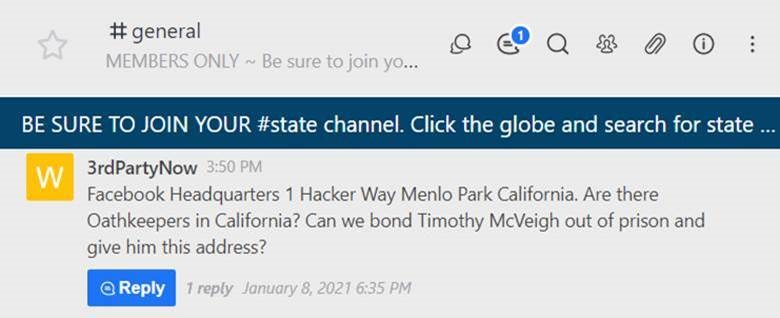
Meanwhile, hundreds of participants in the January 6 riot were quickly identified by amateur sleuths, researchers, and law enforcement. Police soon began arresting and charging individual rioters, sending paranoia and fear rippling throughout extremist communities online.
As of December 2021, law enforcement has charged more than six hundred eighty-five people for crimes committed while participating in the January 6 insurrection; the government has used evidence collected from social media platforms in more than 85 percent of these cases. Those arrested and charged included individuals associated with more than a dozen extremist movements, including the Proud Boys, Oath Keepers, Three Percenters, QAnon adherents, and white supremacists. Though members of these movements participated in the attack, a majority of those arrested were not identified as members of such groups in charging documents.
Narrative: The people being charged for their involvement in the insurrection are political prisoners
February 4
The Proud Boys circulate links soliciting funds for members who have been arrested for their role in the insurrection.
June 9
At a Florida baseball game Proud Boys members drop a banner stating, “Free All Political Prisoners 1/6/21.”
July 29
Four Republican representatives visit a DC jail with far-right media outlets, implying the jail is mistreating prisoners and that January 6 was justification for imprisoning Trump supporters. Footage from the visit angers extremists.
September 17
The Gateway Pundit launches a database of January 6 “political prisoners” called “American Gulag,” which solicits donations
September 18
An enterprising Trump supporter holds a sparsely attended DC rally for January 6 political prisoners.
Though the attack initially thrilled extremist movements, it ultimately resulted in severe internal tumult. Some group members cautioned each other about saying too much, and users who expressed violent desires were accused of being part of government plots to entrap others. Leaders of extremist groups tangled in bouts of online insults and infighting, wildly speculating about each other’s potential cooperation with law enforcement. Distrust and turmoil extended to real-world organizing, causing many events that had been scheduled for the weeks following the riot to fall apart.
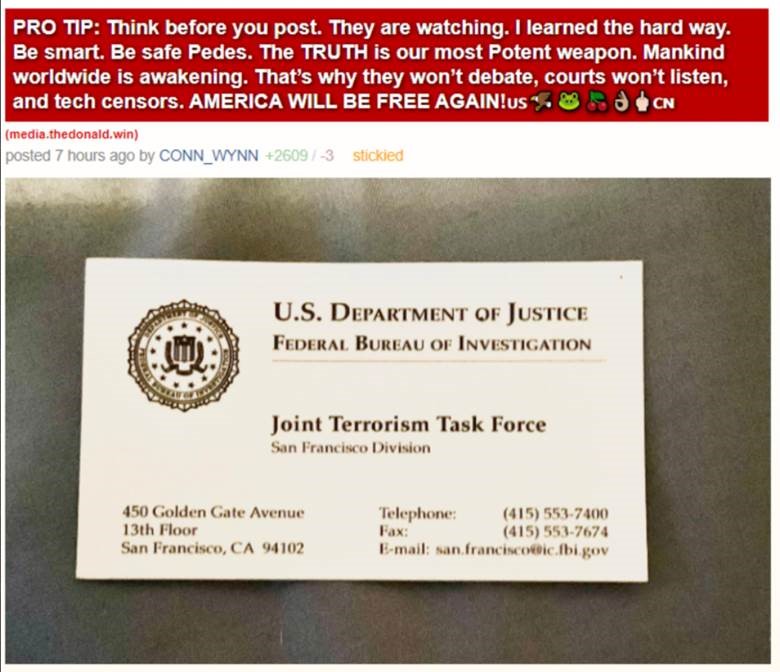
Many extremist-movement leaders eventually discouraged their supporters from attending any political rallies for a time, warning that in-person events might be clandestine ambushes by federal law enforcement to bait Trump supporters into the open and arrest them. Stewart Rhodes, leader of the Oath Keepers, sent a “warning order” to his members, urging that they beware “false flags and traps that are now being set” and avoid events at state-government buildings. A national Three Percenter organization echoed that call for caution in a public statement, warning that some of the gatherings proposed in response to Biden’s inauguration were either designed to build out federal databases for a domestic terrorist list or to create justifications for changing gun-ownership laws. Some groups like the Proud Boys urged members to observe a temporary hiatus from political activity altogether. Fear and paranoia soon overrode many extremist movements’ decision-making; as that skittishness spread, those who had proposed events—particularly ones in Washington, DC—largely called them off.
The same hesitancy against real-world organizing carried on throughout the spring of 2021, with just a handful of exceptions. Groups like the Proud Boys continued to discourage attending protests during the trial of Derek Chauvin, the Minneapolis police officer eventually convicted of murdering George Floyd in 2020. Contentious cultural moments like Chauvin’s trial are often targets for far-right organizing, but the broader movement generally obeyed the consensus to stay away.Minnesota Proud Boys, Parler, accessed November 1, 2021
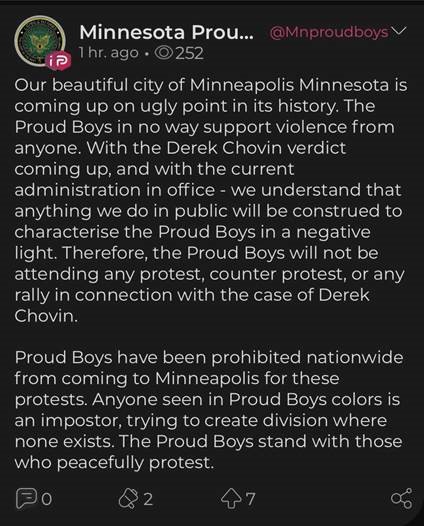
Paranoia was palpable in articles published by right-wing conspiracy-theory blogs popular with extremist movements and election deniers. Gateway Pundit, which acted as a leading hub for election-related misinformation in 2020, published articles discouraging protest attendance and proclaimed feverish allegations about how they had been organized. One headline alleged that proposed armed protests at state capitols on January 17 were a “possible sinister plot hatched by radical left to take away gun rights.”

After users of online forums and groups linked to the attack shared that they were visited or contacted by law enforcement, some communities began posting hostile content aimed at investigators they assumed were observing their digital habitat. Other communities and activists scrambled to avoid accountability for their roles in promoting the conditions and attitudes that ultimately produced the Capitol attack. Major pro-Trump social media influencers like Jack Posobiec deleted tweets that contained references to the Stop the Steal campaign that preceded January 6, while pro-Trump online forum The Donald deleted weeks’ worth of material posted prior to the riot from its archive. (The Donald later rebranded itself as Patriots.win.)
Ali Alexander, who spearheaded the Stop the Steal movement, reportedly went into hiding and begged his supporters for tens of thousands of dollars he claimed would be spent on private security protection for himself. Some organized extremist groups like The Three Percenters Original—one of the oldest and largest online groups of Three Percenter supporters—shut down altogether, while extremist leaders like Proud Boy Ethan Nordean made public statements announcing their departures from far-right political organizing.
Meanwhile, in the hours following the riot, social media companies began taking action on their platforms in response to the attack. That evening, YouTube, Twitter, Facebook, and Instagram removed videos uploaded by Trump on their platforms, in which he continued to allege wrongdoing during the 2020 election but told rioters to go home. Facebook also removed a text post from Trump that told participants to “remember this day forever.”
Later that night, Facebook published a blog post stating it was taking increased measures to prevent election misinformation from spreading unimpeded, limiting content in groups with high rates of hate speech, and searching for and removing content that praised the attack or sought to incite further dangerous events. Twitter removed several of Trump’s tweets it said violated its Civic Integrity Policy and locked his account for twelve hours, ultimately removing the account altogether. Snapchat suspended Trump’s account after the riot, as did platforms Shopify and Twitch. Trump was also suspended from YouTube, with YouTube Chief Executive Officer Susan Wojcicki later telling Atlantic Council President Frederick Kempe at a March 4 online event that the “elevated-violence risk still remains,” and YouTube would lift the suspension when “the risk of violence has decreased.” These bans remained in place throughout 2021.
Beyond Trump himself, far-right and extremist communities that had previously avoided online repercussions also suffered blowback. After the attack, app stores hosted by Apple and Google removed Parler, an alternative platform popular among riot participants and their supporters. Amazon Web Services kicked Parler from its cloud hosting service, effectively taking the site offline. Chatroom app Discord ejected a community of supporters from The Donald forum, where much violent rhetoric appeared prior to the attack. Twitter also reinvigorated its efforts to curb QAnon conspiracy-theory messaging on its platform and booted Stop the Steal organizers like Ali Alexander off its service. Some alternative platforms, including Parler, made small efforts to curb extremist content, reneging on their promises to prospective users of a hands-off, “free-speech” moderation practice.
Many groups and activists who participated on January 6 also lost access to online payment processors, hosting providers, and other digital services after those companies faced renewed public pressure to crack down on extremists. A leading Three Percenters website lost its host after Wix ended its service agreement; the Oath Keepers lost access to web hosts and payment processors like Stripe; email listserv platforms ditched Stop the Steal promoters like white nationalist Nicholas Fuentes; and video-streaming platforms like DLive removed notable extremists from their services. Some groups also experienced compromises to their digital infrastructure and security, resulting in their members being identified publicly.
Timeline of data breaches
January 11
News breaks that hackers scraped Parler data to archive material from the platform.
January 16
Unicorn Riot publishes Discord chat logs related to the Capitol attack.
March 1
Hackers announce data breach of Gab, obtaining more than seventy gigabytes of information “representing more than 40 million posts.”
March 3
American Patriots Three Percentage website data compromised.
March 15
Hackers dump data from online gun purchasing website.
April 10
GiveSendGo, a crowdfunding platform popular with extremists, suffers a data breach.
June 28
Sons of Confederate Veterans information exposed by the Guardian.
July 6
Unicorn Riot publishes leaked Discord chat records from Three Percenter Security Force.
September 13
Hackers announce they’ve obtained data from Epik, a web-hosting service that facilitates far-right web infrastructure.
September 27
Hackers release data from The Oath Keepers, including data from chat servers, emails, and lists of members.
September 29
Hackers release a second trove of data from Epik that includes bootable disk images.
October 3
Hackers release even more data from Epik, including material from the Republican Part of Texas.
In the riot’s aftermath, federal law enforcement and national security agencies issued bulletins and gave public statements that identified domestic extremist movements as a leading threat to the US homeland. Representatives from those agencies assured the public that they would use their resources to prioritize addressing threats within the nation’s borders. Members of Congress, meanwhile, have debated drafting new laws, reallocating funds, and devoting resources to understanding and combating homegrown terror. At the time of writing, the House Select Committee to Investigate the January 6th Attack on the United States Capitol continues to investigate and interrogate the events of that day, in hopes of holding accountable those in positions of power and influence who share responsibility for the most blatant assault on US democracy in living memory.
“We are so back”: Rehabilitation, rebranding, and revisionism
Extremist movements and the threats they pose to democracy are still pernicious and immediate; the post-Capitol attack turmoil left them battered, but not broken. By the summer of 2021, many domestic extremist movements began attempting to rebuild their organizations in hopes of reemerging in mainstream political conversations and regaining the influence they previously experienced during the years of the Trump administration. The sentiments of these groups remain among the leading narratives present in mainstream conservative rhetoric today, regularly receiving sympathy and repetition from Republican officials and partisan media outlets from Fox News to One America News Network. This includes an ongoing process of historical revisionism, rebranding the insurrectionists who attacked the Capitol as patriots and heroes.
Narrative: The insurrection was a false flag done by the government or leftists, not Trump supporters
January 6
Rep. Paul Gosar tweets the attack “has all the hallmarks of Antifa provocation.”
House republican leader Kevin McCarthy claims President Donald Trump said in a call that the insurrectionists were actually Antifa. (This information was not publicly known until Rep. Jaime Beutler released a February 12 statement.)
February 23
Reading a January 14 article by The Federalist into the Senate record, Sen. Ron Johnson says there were “fake Trump protesters” and “agent provocateurs” at the insurrection. He quotes the article to note the “jovial, friendly, earnest demeanor” of the majority of the protesters that day. The Federalist article also speculates that the fake Trump protesters were Antifa.
May 12
At a hearing on the insurrection, Rep. Andy Biggs shows video of alleged Antifa violence in Portland, while Rep. Andrew Clyde dismisses the insurrection, stating “there was no insurrection” and “if you didn’t know the TV footage was a video from January 6th, you would actually think it was a normal tourist visit.”
June 14-16
Darren Beattie, the author of several Revolver pieces spreading conspiracies about the insurrection, is a guest on Tucker Carlson’s Fox News show to talk about how the FBI was behind January 6. Clips of the segment are shared by Rep. Matt Gaetz, Rep. Marjorie Taylor Greene, and Glenn Greenwald on Twitter. A Beattie article is also read into the congressional record by Rep. Gosar.
October 21
Rep. Thomas Massie asks Attorney General Merrick Garland whether or not there were federal agents involved in the insurrection, and tweets a clip of the questioning.
Networks of far-right influencers banned from mainstream platforms in the wake of the Capitol insurrection have sought to rebuild their audiences on a range of alternative platforms, with varying degrees of success. Organized extremist groups, particularly those involved in the Capitol attack, have retooled their approaches to building online movements. Unlawful private militias, for example, have posted messages on their respective platforms indicating that their recruitment strategies would incorporate more traditional methods, like soliciting at in-person events. Groups like the Proud Boys have revamped their process for investigating would-be members prior to accepting them into their ranks.
Many extremist groups and activists have instructed their followers to channel their priorities toward the state and local levels, rather than consolidate their numbers at national protest events. While some calls for national gatherings have emerged since the Capitol attack, most have gone unanswered. Even events that received significant publicity, like the September 2021 “Justice for J6” rally in Washington, DC, a far-right solidarity event in support of arrested rioters, failed to produce the kind of turnout seen in the lead-up to January 6. Calls to action that were answered often resulted in clusters of local activity, rather than anything at the national level.
Groups that engaged in lower-profile political activism found there is often less media coverage and fewer coordinated resources to oppose them. Able to evade communities’ paranoia over national events, some groups have recently turned to targeting schools and local elected officials to exercise public pressure campaigns in hopes of getting local institutions to bend to their agenda. Surviving far-right movement groups are organizing around many of the same causes they promoted nationally prior to the 2020 election. They have organized protests at city councils, schools, and government buildings to press officials to act on conspiracy theories about the legitimacy of the 2020 election, to channel opposition to racial justice via protests and confrontations over disingenuous allegations that “critical race theory” was being taught to children in public schools, and to express opposition to COVID-19 safety measures, among other issues.
In some locales, extremists have been able to steer their causes under the radar, avoiding national scrutiny. Outside of Portland, Oregon, far-right groups including Patriot Prayer, People’s Rights, and the Proud Boys spread calls on the messaging app Telegram to appear outside an area school to oppose COVID-related mask requirements. The protest triggered the school district to go into lockdown. Members of the Proud Boys have also joined protests outside the homes of local public officials, including a school-board chairwoman in Florida. Across the country, school-board members are resigning due to these pressures. At the time of publishing, the ballot-tracking initiative Ballotpedia had identified eighty-four separate recall efforts targeting two hundred fifteen school-board officials over the course of 2021; in 2020, there were twenty-nine recall efforts targeting sixty-four officials.
Other extremist movements have taken an opposite approach: attempting to inject themselves into more mainstream conservative political arenas in hopes of building broader support. Some groups have taken cues from mainstream pro-Trump voices to assist their own efforts. Former Trump administration National Security Advisor Michael Flynn, who had been embraced by the QAnon community for many years, told a conference crowd in June 2021 that it was crucial to get involved in their local communities, arguing that local action can have national consequences. His call was subsequently spread among QAnon-supporting communities online. Similar calls to action have been made by other pro-Trump influencers like Steve Bannon, who has repeatedly urged supporters to seek positions of power in the Republican Party at the grassroots level, and to work their influence upward through the party until they assume broader control.
And, it appears that many followers have answered those calls. Bannon’s advocacy has reportedly produced waves of individuals expressing new interest in obtaining party positions in key precincts, opening the potential to reshape how those precincts influence elections. Dozens of candidates who have pushed QAnon conspiracy-theory rhetoric online have declared candidacies for elected offices in the upcoming year, in addition to other far-right demagogues like anti-Muslim activist Laura Loomer, who is running for a US House seat in Florida in 2022. Some far-right activists have organized more traditional activism calls to action like phone banking to promote modifications to a technology bill in Florida backed by the state’s governor, Ron DeSantis. The bill, signed into law by DeSantis in May 2021, seeks to enable the state to punish tech companies financially for removing political candidates from their platforms. And, far-right figures, including Loomer, bragged that their pressure campaigns influenced modifications to the law to increase financial penalties, though lamented that they did not get all the modifications they desired.
Other extremist figures have launched nonprofits. Nicholas Fuentes, the white-nationalist podcaster involved in Stop the Steal events, launched the America First Foundation, whose mission is “to educate, promote, and advocate for conservative values based on principles of American Nationalism, Christianity, and Traditionalism.” Lauren Witzke, a former congressional candidate in Delaware who has allied herself with extreme political activists and personalities, formed a political action committee (PAC) that states it will “fight the Godless left so that the church pews remain full and until the Democrat coffers are drained empty.”[13]
True believers who may be unsuccessful in pursuing elected office still find value in the endeavor, believing it will push their opponents closer to their own movement’s ideals, raise their public profile, or be a profitable endeavor. In multiple states, officials have formed coalitions based on lies about the 2020 election, while a group of QAnon-friendly secretary of state candidates from five key states and a potential gubernatorial candidate in Pennsylvania are working together in hopes of taking over election-oversight bodies.
Organized extremist groups like the Oath Keepers have adopted similar modes of thinking, with instances of members encouraging each other to push into the mainstream GOP and cement their gains from within the party. In one Oath Keeper discussion room monitored by the DFRLab, users passed around resources on activism training by mainstream conservative organizations such as the Leadership Institute and the National Rifle Association.
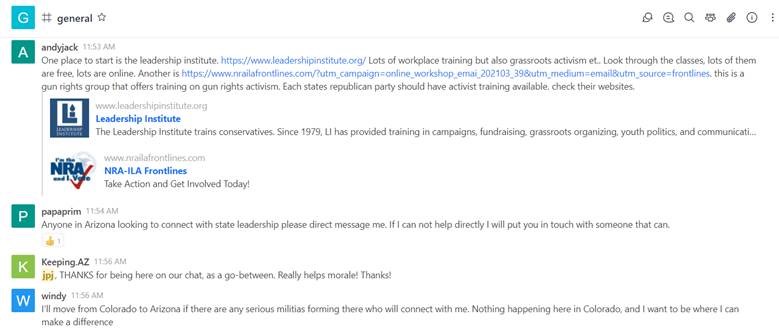
Some in the broader extremist movement community turned away from street protests after January 6 in favor of attending conferences, several of which have attracted elected officials. One of the first organized events from a faction of extremists who participated in the Capitol insurrection took place in parallel to the 2021 Conservative Political Action Conference (CPAC) in Orlando, Florida. (CPAC itself was not involved in the event.) At a nearby hotel conference room, white nationalists including Nicholas Fuentes hosted the event, dubbed the America First Political Action Conference (AFPAC). At the single-night event, ticketholders mingled with supportive far-right media figures and listened to keynote addresses from Rep. Paul Gosar (R-AZ) and former Iowa Rep. Steve King.
The QAnon conspiracy theory movement has also brought together its adherents for real-life gatherings. Several of these conferences have featured appearances from notable conservative media influencers, political candidates, and elected officials. Neo-Nazi groups, though unable to bring in elected officials to date, have also chosen to bring together supporters at small-scale conferences and gatherings. These conferences ostensibly serve as more professional and secure gathering places for supporters, as well as revenue streams for their movements’ broader ambitions.
Other extremist groups, meanwhile, have decentralized, choosing to decouple from national organizations as a method of survival during a time of increased scrutiny. For example, several disgruntled chapters of the Proud Boys declared their independence from the national organization in early 2021. Pushes to decentralize have also affected communications between members and factions of extremist movements, compartmentalizing internal discussions in the process.
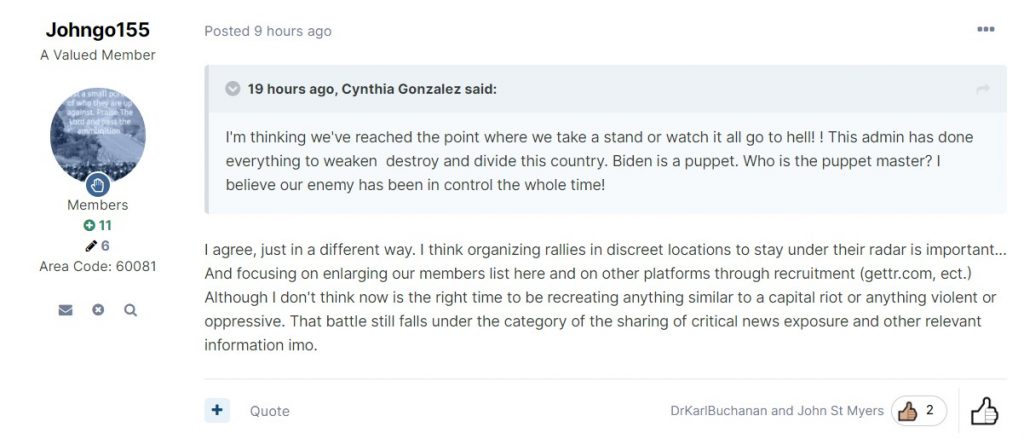
Decentralizing has also extended to extremist movements’ organizing efforts. One such effort, calling itself “White Lives Matter,” has promoted monthly dates for loosely coordinated action in which its participants stage small protests or place white supremacist propaganda in public spaces. The effort was primarily active in select regions of the United States, but organizers have claimed a degree of participation from sympathizers internationally. Those behind the push, known to be Proud Boys supporters, instructed followers and activists to conceal their identity both online and during in-person events, going so far as to publish a twelve-page operational security guide with instructions for doing so. The decentralized ethos of the campaign has also provided windows for the white supremacist movement’s most radical elements to participate with other extremist groups under a veil of plausible deniability for less radical groups.

In response to major social media platforms accelerating their moderation efforts against known extremist entities, several movement factions turned more intentionally to existing alternative social media services. Since the Capitol attack and resulting crackdown on certain kinds of misinformation, a host of new platforms have become destinations for audiences—including extremists—disaffected by those moderation decisions. For months, far-right groups and supporters bounced between platforms before largely settling on a small handful of new venues. These communities also urged supporters to ditch mainstream web services for alternatives promising less data collection and tracking. Though some platforms like Parler and Gab experienced security breaches and downtime in the months following January 6, most of those affected managed to return to their prior capacities.
Right-wing influencers and their engagement on alt platforms
In the wake of the major social media platforms suspending accounts of people and groups who participated in the January 6 attack, communities on the far right began to scatter across alternative platforms, hoping to gain a foothold elsewhere. Some of these platforms, like Telegram, attract a range of users and are more broadly popular, while others like Parler and Gab are niche platforms that cater to the far right. Data collected by the DFRLab represent the monthly volume of posts by right-wing influencers across platforms. Note that data from the Oath Keepers channel on MeWe differ from the others in the set, as they are sourced from a community page rather than an individual’s profile.
As can be seen in these charts, some only reestablished themselves after they had been banned elsewhere, including the Oath Keepers community on MeWe, or former Trump attorney Lin Wood relocating to Telegram. Others, including Proud Boys leader Enrique Tarrio, Stop the Steal founder Ali Alexander, and former Trump lawyer and conspiracist Sidney Powell, began to establish their presence on alternative platforms prior to January 6, only to fully embrace them after their banishment from the more mainstream platforms.
Some social platforms like Gab and video-hosting platform Odysee have actively courted disgruntled, radicalized users. Gab CEO Andrew Torba made his own far-right beliefs a selling point of his platform, while Odysee promised extremists a blockchain-powered service that made content practically impossible to remove from existence. Other platforms seem to have turned a blind eye to extremist activity, like the crowdfunding site GiveSendGo, which has been utilized by far-right groups and individuals to raise money for legal battles stemming from the Capitol insurrection, among other projects.
Factions of US extremist movements unsatisfied with the offerings on alternative social platforms have created their own platforms, granting them final say over what is taken down (or rather, not taken down) from their domains. Gab’s Andrew Torba spent 2021 further expanding his platform’s branded web infrastructure to include a web advertising service and a payment processor. The individuals behind The Donald forum, where a lot of violent rhetoric appeared prior to the Capitol attack, continued to expand to adopt new conspiratorial and far-right communities banned from Reddit. Conspiracy theorist and pillow maven Mike Lindell created a proprietary video-hosting platform, as did white nationalist Nicholas Fuentes and his fellow extremist influencers. Though Lindell and Fuentes’ efforts vary in technical sophistication and audience engagement, both exist as independent platforms for extreme content.
“We’re back. We’ve got everybody on the same platform,” Fuentes told his supporters during a livestream on his new platform on October 21, 2021. “We can’t be censored. We can’t be de-platformed. We’re all here…I was just looking at that and thinking, ‘We are so back. We did it!’”
Movements that sought to return to or remain on mainstream platforms have deployed coded language and parallel rhetoric to evade detection from moderators. Those supporting the QAnon movement, for example, have strayed away from using their shared common language and catchphrases when communicating publicly on major social media platforms. Militia groups that reemerged on Facebook after the platform acted against unlawful militia groups attempted to do so under branding that obscures their intentions.

Together, these developments offer extremists sufficient conditions to continue metastasizing and recruiting. Though most online tools adopted by extremists enable them to reach smaller audiences than those possible on mainstream social media, they may be more effective in intensifying the radicalization of individuals already engaged with them. Shifts in prioritization toward local action also demand less of movements’ access to mainstream platforms and the mass audiences they can engage, because would-be participants in such actions make up a smaller, targeted set of individuals. And, conducting activism on smaller scales enables them to operate without the scrutiny or detection that doing so on a national scale often brings with it.
In this setting, the attitudes and talking points of conspiracy theorists and extremists have crawled further up the conservative ideological food chain since January 6, reaching major figureheads like Fox News host Tucker Carlson. The mainstream adoption of far-right talking points makes the networking component of any given extremist organization less important, and their access to large audiences less necessary, for spreading their ideas.
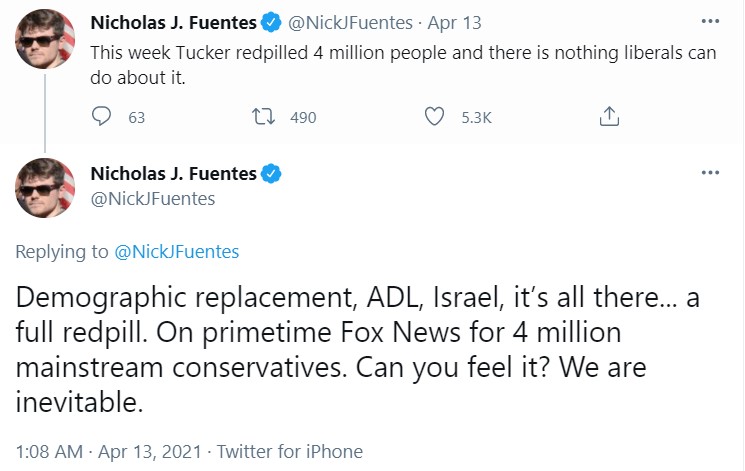
Many of the new extremist groups that emerged in 2021 channel the ideologies of preexisting movements and organizations but under new names or presentation styles. The Washington state chapter of People’s Rights, founded by long-time antigovernment activist Ammon Bundy, who participated in a violent standoff with the US government in 2014, renamed itself Neighbors United in March after the organization began receiving some of the public scrutiny that other far-right movements faced after the Capitol attack. Despite the name change, the organization is still firmly planted in Bundy’s People’s Rights organization, spreading messages for both Neighbors United and People’s Rights Washington in its Telegram channel and appearing at the same events together.
Some groups have moved much of their conversation out of the public eye, or have embraced two-front communication styles, presenting one image to the public and another image behind the scenes. In this approach, groups and movements promote themselves on publicly viewable channels for would-be recruits, media outlets, and other community members, while maintaining smaller private chat rooms for vetted members.
In September 2021, the DFRLab published an investigation into a Pennsylvania-based group called Proud American Patriots Network that appeared to conceal its Three Percenter movement connections beneath the veil of an unremarkable political nonprofit group.[2] The group, spearheaded by a husband-and-wife duo, endorsed candidates, offered a scholarship, and solicited donations and sponsorships. But, within documents reserved for its members, the group stated its desire to build a training facility to train members in lethal force, as well as its connections to Three Percenter ideology. Online, supporters of the group solicited members from a pro-militia forum board. After local backlash, the group took further efforts to obscure its foundations in the militia movement.

“A parallel society”: Prepper mentality spreads
The notion of creating a separate mode of living that can self-sustain a nominal type of Christian, hyper-conservative way of life and weather a perceived societal collapse has gained traction among some extremist and conspiracy communities, particularly in the wake of Capitol-riot fallout. Channeling their own interpretation of “prepper” philosophy, many influencers popular with far-right audiences have gone as far as to sell doomsday supplies like buckets of food and tactical supplies.
The post-January 6 landscape also reinvigorated discussions of a looming civil war or “national divorce”—the latter of which, according to its proponents, would seek to split the country legally rather than through violence. Extremists and mainstream Republican commentators alike have produced online content weighing the legitimacy of such ideas, and many have come across as generally sympathetic.
Some extremist elements, including militia groups, have used similar rhetoric in their recruitment pitches. “We are at war. Just a different type of war,” a post from MyMilitia user YellowstoneMilitia read. “The bullets haven’t started flying yet. But give it time and they will.”
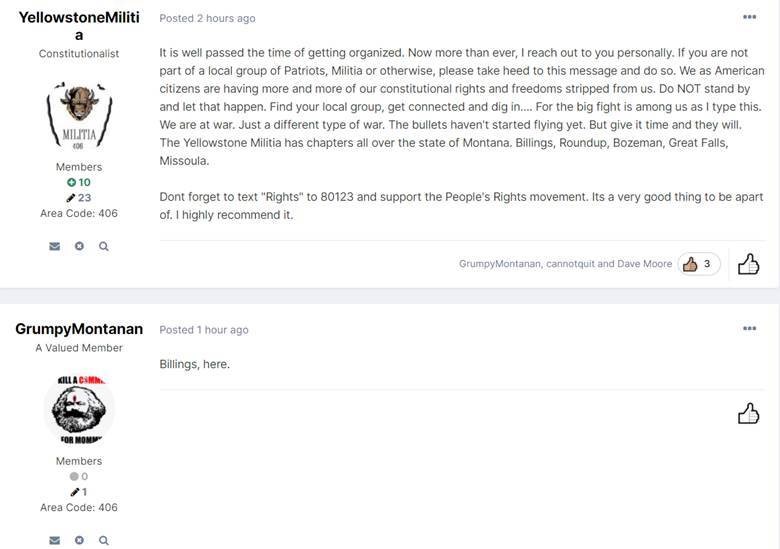
Several far-right individuals and groups have advocated creating parallel tools for far-right political supporters to utilize that do not rely on mainstream internet infrastructures. Gab Chief Executive Officer Andrew Torba has been a staunch advocate of this push, using his company to build online what he calls a “parallel Christian economy” comprising a social platform, a web commenting system, video hosting, an advertising service, and a payment processor. Torba has been clear that his intentions behind doing so stem from a desire to allow his own far-right sentiments to survive online despite moderation actions by major platforms to limit hate speech and extremism online.
“We must do everything we can right now to peacefully protect our freedom by building a parallel society,” Torba wrote in a September 9 blog post. “It’s baffling to me how people do not recognize the urgency of the situation we are in. We have lost so much over the past 18 months and we will never get it back unless we start taking a stand right this second.”
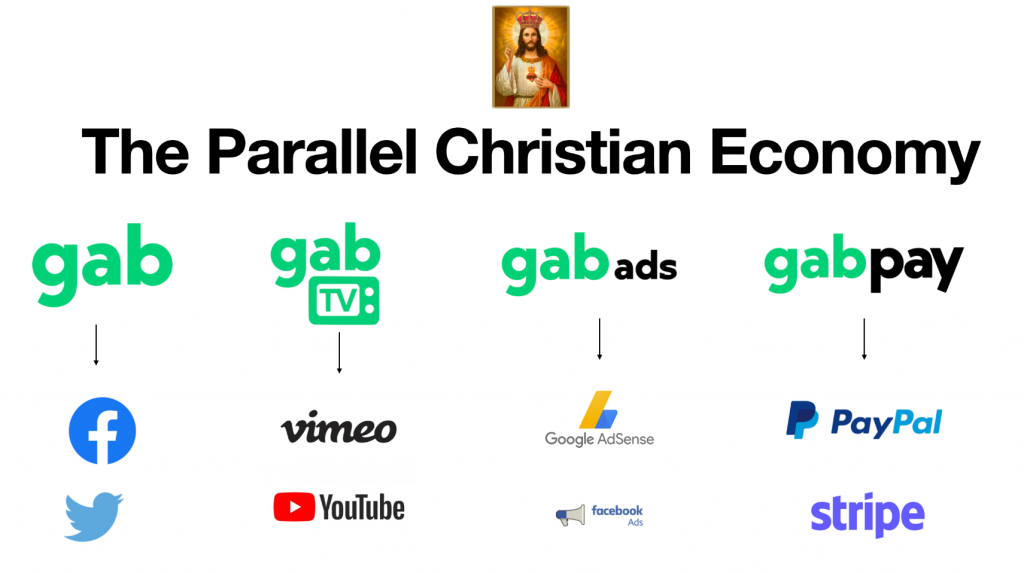
On August 15, Torba invoked the idea of a parallel societyAndrew Torba, “If a bunch of dudes who hid in caves for twenty years can take their country back from the Globalist American Empire then there’s no reason we can’t too. All we have to do is exit their system and build our own,” Gab, August 15, 2021, https://web.archive.org/web/20210815182018/https://gab.com/a/posts/106761498287049665; Holt, “Blockchain-Based Video Platform Attracting Far-Right Users Uses Hate-Site Infrastructure.” after the Taliban rapidly regained control of Afghanistan following the withdrawal of US and allied forces, writing on his Gab profile that the takeover was something of which his likeminded followers could also be capable. “All we have to do is exit their system and build our own,” he wrote.
Narratives about the formation of a parallel society have caught on, particularly with Christian nationalists and separatists. They have also found homes in hardcore conspiracy-theory communities online. Many of these calls effectively build on growing antigovernment sentiment in far-right online communities and drive action toward disengaging with society on a broader scale to weaken the United States under the Biden administration and exist apart from what they perceive to be the intolerable liberal consensus formed in society.
Michael Hill, leader of the Neo-Confederate hate group League of the South, urged secession in a January 29 blog post, arguing that US citizens should “withdraw your consent to being governed.”
“State and local governments, the lesser magistrates, to interpose themselves between their citizens and the corrupt DC regime and, when necessary, to nullify any attempts to deprive those citizens of the protection of the law as given us by our Founders,” he continued. “And we encourage them to begin looking seriously at the prospects of secession.”
Additionally, a small crop of tech experts has emerged to offer guidance to individuals on creating more private, less dependent technology arrangements for themselves. One such advocate is Jeffrey Peterson, a pro-Trump tech entrepreneur. On Telegram, Peterson has provided advice and instructions for transitioning to Linux operating systems and deploying software like virtual private networks (VPNs) to protect users’ digital privacy. In an October 11 post on Telegram, Peterson stated that his channel was started “with the goal to help Americans defend against ‘big tech’ tyranny” by teaching “a way of completely taking back your Digital Freedom, starting at the ‘system level’ of your devices.” Though unalarming in themselves, Peterson’s channel and lessons have been amplified in prominent QAnon communities on Telegram and by movement influencers like Ron Watkins. One popular pro-QAnon Telegram channel called “We the Media” forwarded a message by COVID-19 conspiracist @KanekoaTheGreat promoting Peterson as a likeminded “tech entrepreneur who is willing to build a parallel digital economy.”
Other efforts to disengage from society have assumed more traditional methods, like purchasing land to facilitate a degree of separation from society. Both Owen Benjamin, an extremist former comedian, and Rod of Iron Ministries, a pro-Trump church that conducts worship services while carrying rifles, have purchased land for their followers to live on and visit.
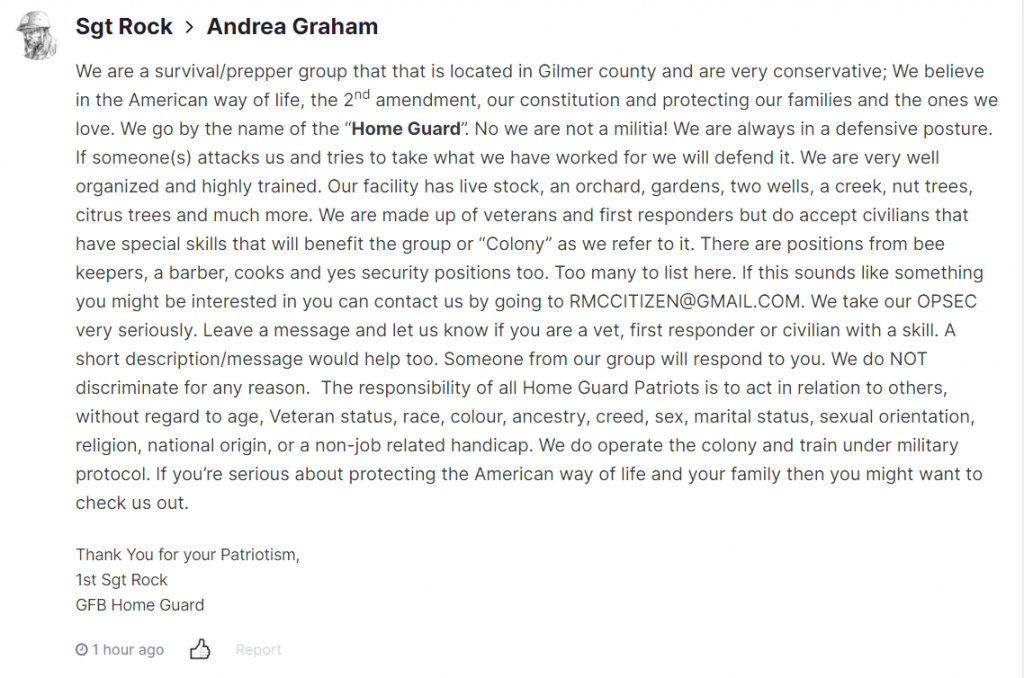
Meanwhile, a Telegram channel promoted by leading election conspiracy theorists that advocates for reviews of all fifty states’ 2020 election results launched into a tirade in late September, after a long-anticipated partisan review of election results in Arizona only managed to prove that Trump lost the state by a higher margin of votes than originally anticipated.
“Are you going to sit around and be told what the next move is by people that clearly don’t know what’s going on or how to conduct a timely audit without internal leaks, OR are you going to take your children’s futures into your own hands and start forming a community in your state to prepare for what’s coming?” the America First Audits channel posted on September 30. “Your children and family are TOP PRIORITY. We are all here fighting for them. We have to be able to brace this storm PREPARED.”
“We will not survive this without a revival across the nation,” it continued. “Start doing your part to make that happen.”
Conclusion
This report is an attempt to synthesize observations and data-driven analysis conducted by the DFRLab over the course of 2021 to provide better understanding of the still-growing threat of domestic violent extremism and political violence in the United States in the aftermath of the January 6 insurrection at the US Capitol. Indeed, the participants and supporters of the Capitol insurrection included many on a broad spectrum of radicalization: enthusiastic Stop the Steal partisans hoping to bear witness to a spectacular historical event; conspiracy-theory adherents believing a prophecy would be fulfilled; ideologues willing to overturn the results of the 2020 election by any means necessary; racially motivated violent extremists; and explicitly antigovernment groups. Each represents an overlapping, connected, but analytically distinct challenge.
Through analysis based on more than a year and half of daily monitoring, the DFRLab identified key trends based on the disruptions these groups faced after January 6, their adoption of new offline and online strategies, and a sustained effort of historical revisionism to rewrite what happened that day.
Many extremist groups have so far failed to fully recover from disruptions post-January 6, including dissension among their ranks, increased national scrutiny, and suspensions by social media platforms. However, others have made troubling progress by shifting to alternative online platforms, embracing rhetoric to engage more broadly with the mainstream conservative base, and engaging in new political activities, particularly public health and education issues at the local level. A common thread remains how the online information environment has accelerated radicalization, hardened increasingly extreme views, and supercharged community engagement.
Far-right influencers who have bolstered extremist ideology to large audiences sought to legitimize antidemocratic attitudes. Their efforts, in many ways, are succeeding. Polling has shown that a low number of conservatives see the Capitol riot as the threat that liberals and independents do, indicating a lack of shared understanding and common concern about January 6’s open assault on US democracy.
Altogether, the threat of political violence in the United States may be diffuse, but it is growing. Strategies to counter domestic extremism must adapt, especially in the online information environment. Though extremist movements face more exposure and scrutiny, the threats they pose to the nation’s security and democratic foundations remain a paramount concern.

